MNG81001 - Strategy Execution via Leadership Communication Report
VerifiedAdded on 2023/06/09
|7
|1088
|63
Report
AI Summary
This report examines the evolving role of leadership communication in executing business strategies in the 21st century. It analyzes three research articles, focusing on strategic vision, organizational culture, and stakeholder engagement. The report highlights the importance of transparent communication, trust-building, and addressing cultural gaps in a globalized business environment. It emphasizes the need for leaders to effectively communicate the company's vision, manage risks by understanding stakeholder expectations, and leverage technology for strategic communication. The report concludes that a well-established foundation of communication is crucial for navigating crises and achieving market opportunities. Desklib provides a platform for students to access similar solved assignments and past papers for further study.
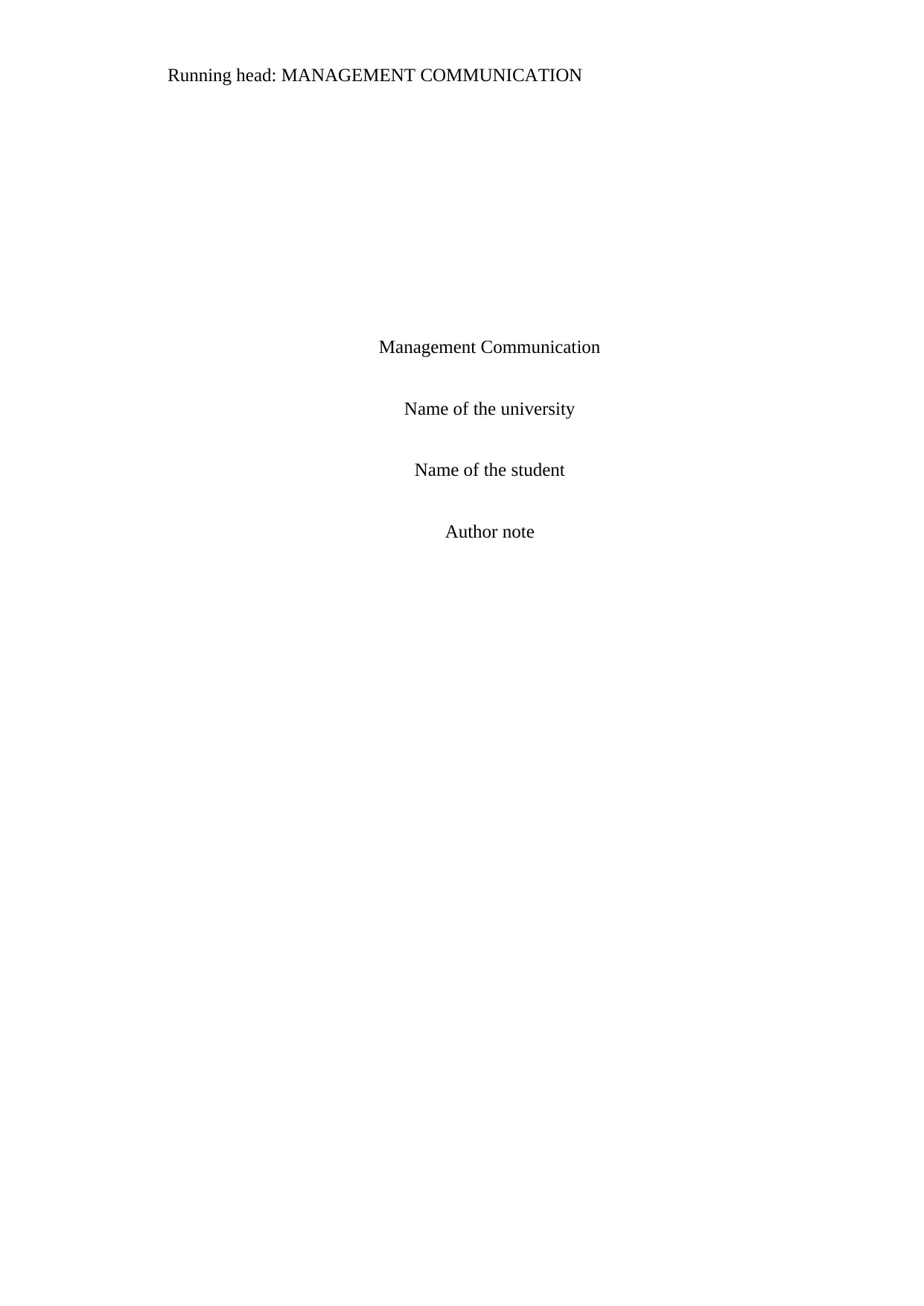
Running head: MANAGEMENT COMMUNICATION
Management Communication
Name of the university
Name of the student
Author note
Management Communication
Name of the university
Name of the student
Author note
Paraphrase This Document
Need a fresh take? Get an instant paraphrase of this document with our AI Paraphraser
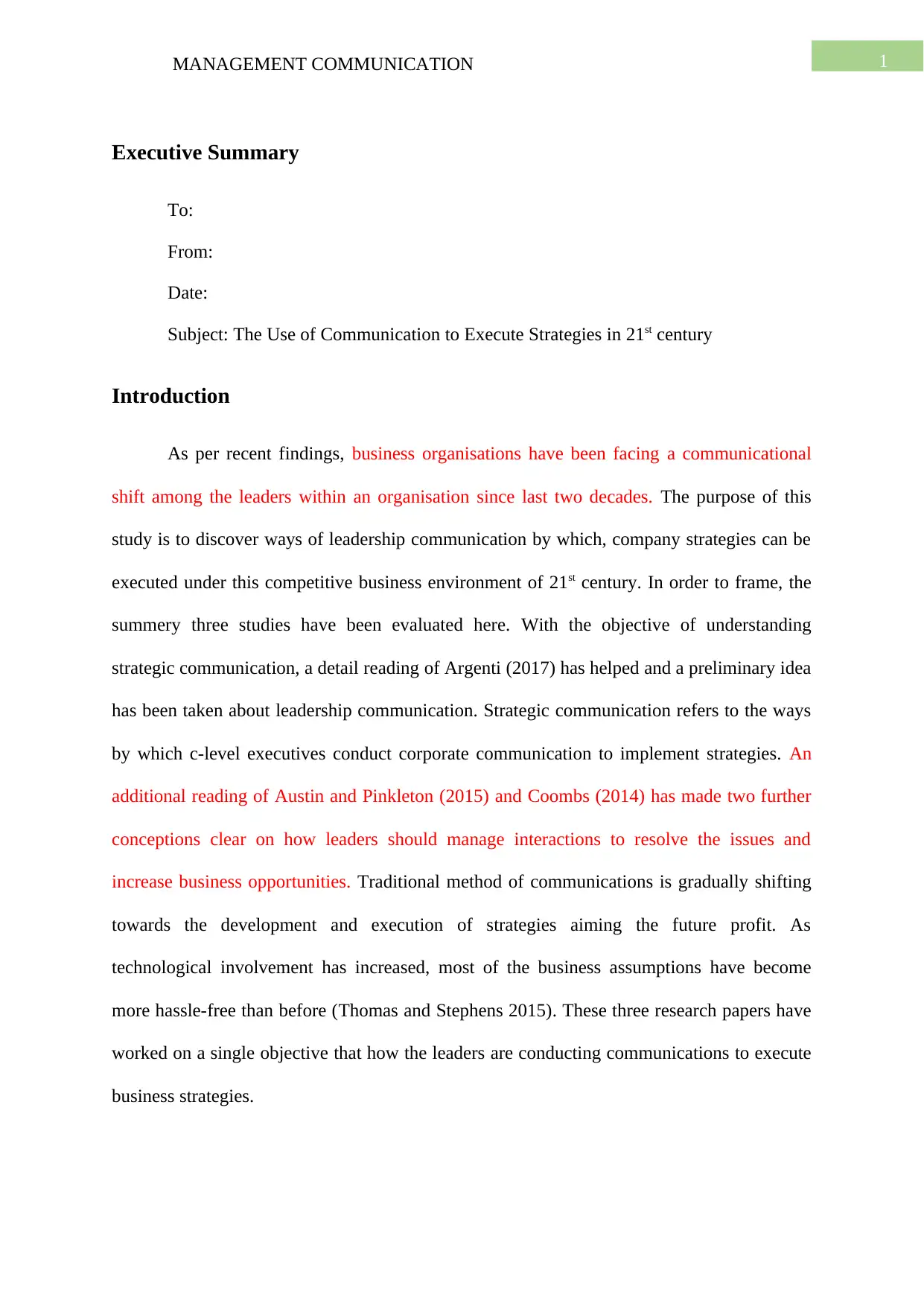
1MANAGEMENT COMMUNICATION
Executive Summary
To:
From:
Date:
Subject: The Use of Communication to Execute Strategies in 21st century
Introduction
As per recent findings, business organisations have been facing a communicational
shift among the leaders within an organisation since last two decades. The purpose of this
study is to discover ways of leadership communication by which, company strategies can be
executed under this competitive business environment of 21st century. In order to frame, the
summery three studies have been evaluated here. With the objective of understanding
strategic communication, a detail reading of Argenti (2017) has helped and a preliminary idea
has been taken about leadership communication. Strategic communication refers to the ways
by which c-level executives conduct corporate communication to implement strategies. An
additional reading of Austin and Pinkleton (2015) and Coombs (2014) has made two further
conceptions clear on how leaders should manage interactions to resolve the issues and
increase business opportunities. Traditional method of communications is gradually shifting
towards the development and execution of strategies aiming the future profit. As
technological involvement has increased, most of the business assumptions have become
more hassle-free than before (Thomas and Stephens 2015). These three research papers have
worked on a single objective that how the leaders are conducting communications to execute
business strategies.
Executive Summary
To:
From:
Date:
Subject: The Use of Communication to Execute Strategies in 21st century
Introduction
As per recent findings, business organisations have been facing a communicational
shift among the leaders within an organisation since last two decades. The purpose of this
study is to discover ways of leadership communication by which, company strategies can be
executed under this competitive business environment of 21st century. In order to frame, the
summery three studies have been evaluated here. With the objective of understanding
strategic communication, a detail reading of Argenti (2017) has helped and a preliminary idea
has been taken about leadership communication. Strategic communication refers to the ways
by which c-level executives conduct corporate communication to implement strategies. An
additional reading of Austin and Pinkleton (2015) and Coombs (2014) has made two further
conceptions clear on how leaders should manage interactions to resolve the issues and
increase business opportunities. Traditional method of communications is gradually shifting
towards the development and execution of strategies aiming the future profit. As
technological involvement has increased, most of the business assumptions have become
more hassle-free than before (Thomas and Stephens 2015). These three research papers have
worked on a single objective that how the leaders are conducting communications to execute
business strategies.
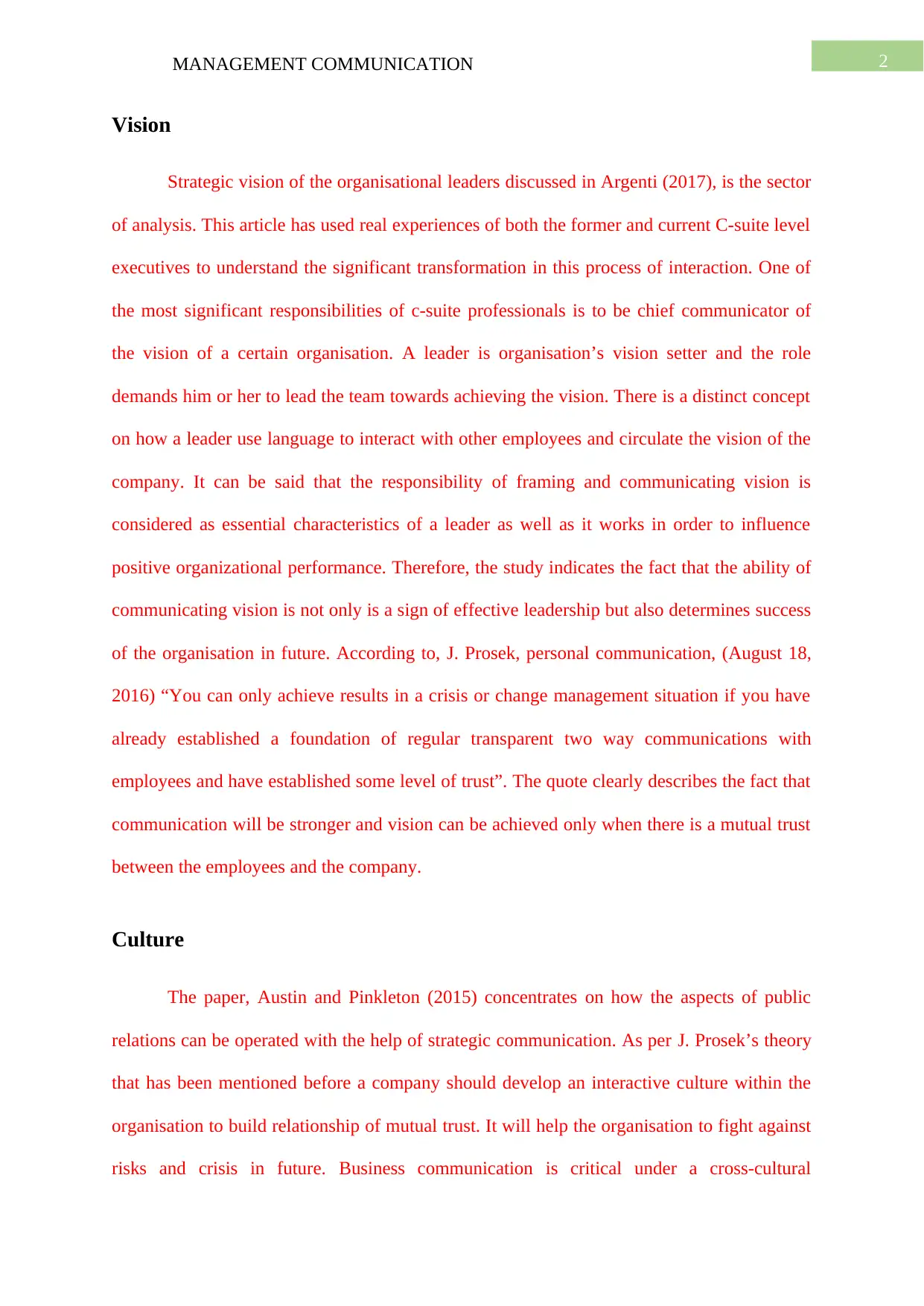
2MANAGEMENT COMMUNICATION
Vision
Strategic vision of the organisational leaders discussed in Argenti (2017), is the sector
of analysis. This article has used real experiences of both the former and current C-suite level
executives to understand the significant transformation in this process of interaction. One of
the most significant responsibilities of c-suite professionals is to be chief communicator of
the vision of a certain organisation. A leader is organisation’s vision setter and the role
demands him or her to lead the team towards achieving the vision. There is a distinct concept
on how a leader use language to interact with other employees and circulate the vision of the
company. It can be said that the responsibility of framing and communicating vision is
considered as essential characteristics of a leader as well as it works in order to influence
positive organizational performance. Therefore, the study indicates the fact that the ability of
communicating vision is not only is a sign of effective leadership but also determines success
of the organisation in future. According to, J. Prosek, personal communication, (August 18,
2016) “You can only achieve results in a crisis or change management situation if you have
already established a foundation of regular transparent two way communications with
employees and have established some level of trust”. The quote clearly describes the fact that
communication will be stronger and vision can be achieved only when there is a mutual trust
between the employees and the company.
Culture
The paper, Austin and Pinkleton (2015) concentrates on how the aspects of public
relations can be operated with the help of strategic communication. As per J. Prosek’s theory
that has been mentioned before a company should develop an interactive culture within the
organisation to build relationship of mutual trust. It will help the organisation to fight against
risks and crisis in future. Business communication is critical under a cross-cultural
Vision
Strategic vision of the organisational leaders discussed in Argenti (2017), is the sector
of analysis. This article has used real experiences of both the former and current C-suite level
executives to understand the significant transformation in this process of interaction. One of
the most significant responsibilities of c-suite professionals is to be chief communicator of
the vision of a certain organisation. A leader is organisation’s vision setter and the role
demands him or her to lead the team towards achieving the vision. There is a distinct concept
on how a leader use language to interact with other employees and circulate the vision of the
company. It can be said that the responsibility of framing and communicating vision is
considered as essential characteristics of a leader as well as it works in order to influence
positive organizational performance. Therefore, the study indicates the fact that the ability of
communicating vision is not only is a sign of effective leadership but also determines success
of the organisation in future. According to, J. Prosek, personal communication, (August 18,
2016) “You can only achieve results in a crisis or change management situation if you have
already established a foundation of regular transparent two way communications with
employees and have established some level of trust”. The quote clearly describes the fact that
communication will be stronger and vision can be achieved only when there is a mutual trust
between the employees and the company.
Culture
The paper, Austin and Pinkleton (2015) concentrates on how the aspects of public
relations can be operated with the help of strategic communication. As per J. Prosek’s theory
that has been mentioned before a company should develop an interactive culture within the
organisation to build relationship of mutual trust. It will help the organisation to fight against
risks and crisis in future. Business communication is critical under a cross-cultural
⊘ This is a preview!⊘
Do you want full access?
Subscribe today to unlock all pages.

Trusted by 1+ million students worldwide
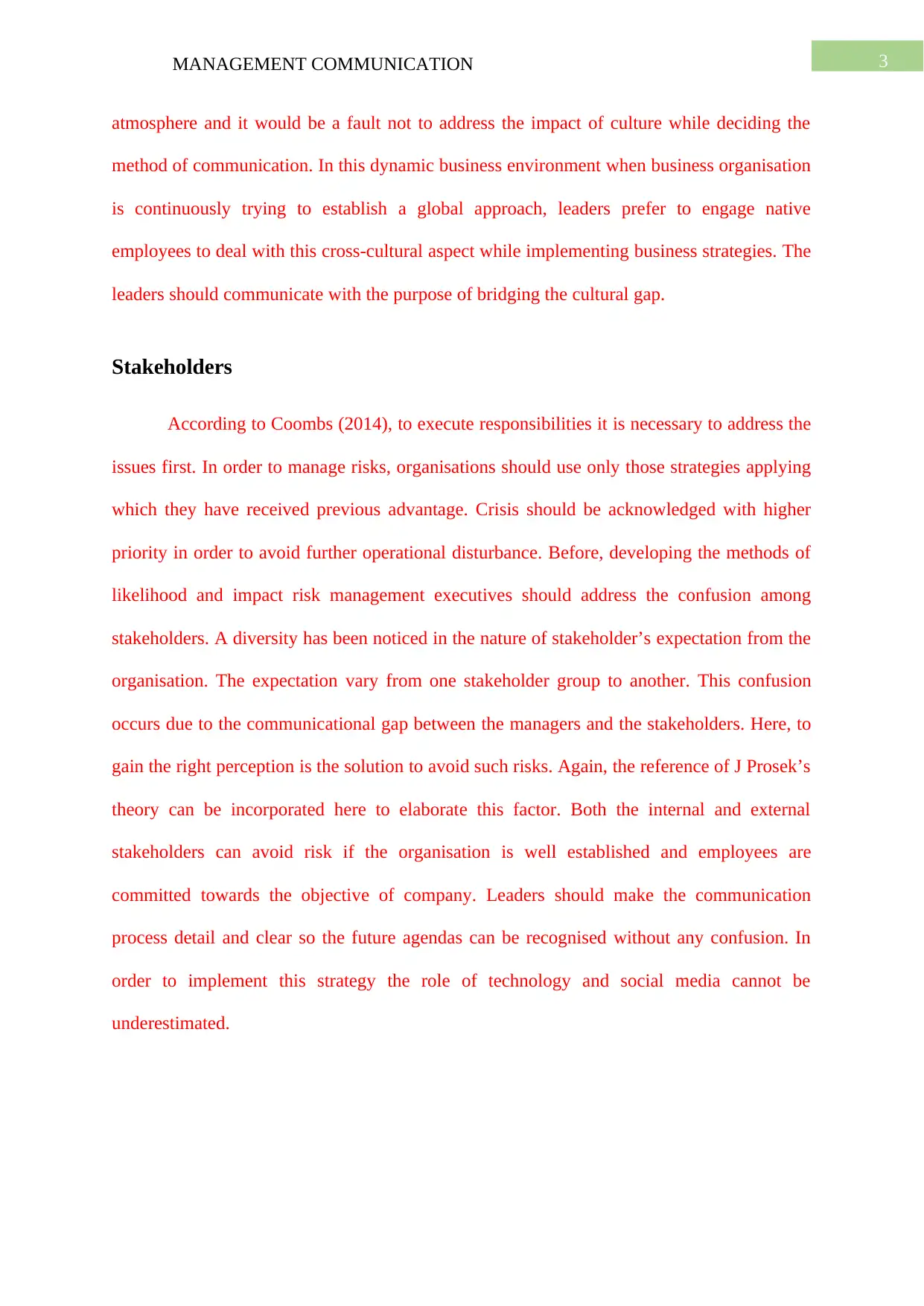
3MANAGEMENT COMMUNICATION
atmosphere and it would be a fault not to address the impact of culture while deciding the
method of communication. In this dynamic business environment when business organisation
is continuously trying to establish a global approach, leaders prefer to engage native
employees to deal with this cross-cultural aspect while implementing business strategies. The
leaders should communicate with the purpose of bridging the cultural gap.
Stakeholders
According to Coombs (2014), to execute responsibilities it is necessary to address the
issues first. In order to manage risks, organisations should use only those strategies applying
which they have received previous advantage. Crisis should be acknowledged with higher
priority in order to avoid further operational disturbance. Before, developing the methods of
likelihood and impact risk management executives should address the confusion among
stakeholders. A diversity has been noticed in the nature of stakeholder’s expectation from the
organisation. The expectation vary from one stakeholder group to another. This confusion
occurs due to the communicational gap between the managers and the stakeholders. Here, to
gain the right perception is the solution to avoid such risks. Again, the reference of J Prosek’s
theory can be incorporated here to elaborate this factor. Both the internal and external
stakeholders can avoid risk if the organisation is well established and employees are
committed towards the objective of company. Leaders should make the communication
process detail and clear so the future agendas can be recognised without any confusion. In
order to implement this strategy the role of technology and social media cannot be
underestimated.
atmosphere and it would be a fault not to address the impact of culture while deciding the
method of communication. In this dynamic business environment when business organisation
is continuously trying to establish a global approach, leaders prefer to engage native
employees to deal with this cross-cultural aspect while implementing business strategies. The
leaders should communicate with the purpose of bridging the cultural gap.
Stakeholders
According to Coombs (2014), to execute responsibilities it is necessary to address the
issues first. In order to manage risks, organisations should use only those strategies applying
which they have received previous advantage. Crisis should be acknowledged with higher
priority in order to avoid further operational disturbance. Before, developing the methods of
likelihood and impact risk management executives should address the confusion among
stakeholders. A diversity has been noticed in the nature of stakeholder’s expectation from the
organisation. The expectation vary from one stakeholder group to another. This confusion
occurs due to the communicational gap between the managers and the stakeholders. Here, to
gain the right perception is the solution to avoid such risks. Again, the reference of J Prosek’s
theory can be incorporated here to elaborate this factor. Both the internal and external
stakeholders can avoid risk if the organisation is well established and employees are
committed towards the objective of company. Leaders should make the communication
process detail and clear so the future agendas can be recognised without any confusion. In
order to implement this strategy the role of technology and social media cannot be
underestimated.
Paraphrase This Document
Need a fresh take? Get an instant paraphrase of this document with our AI Paraphraser
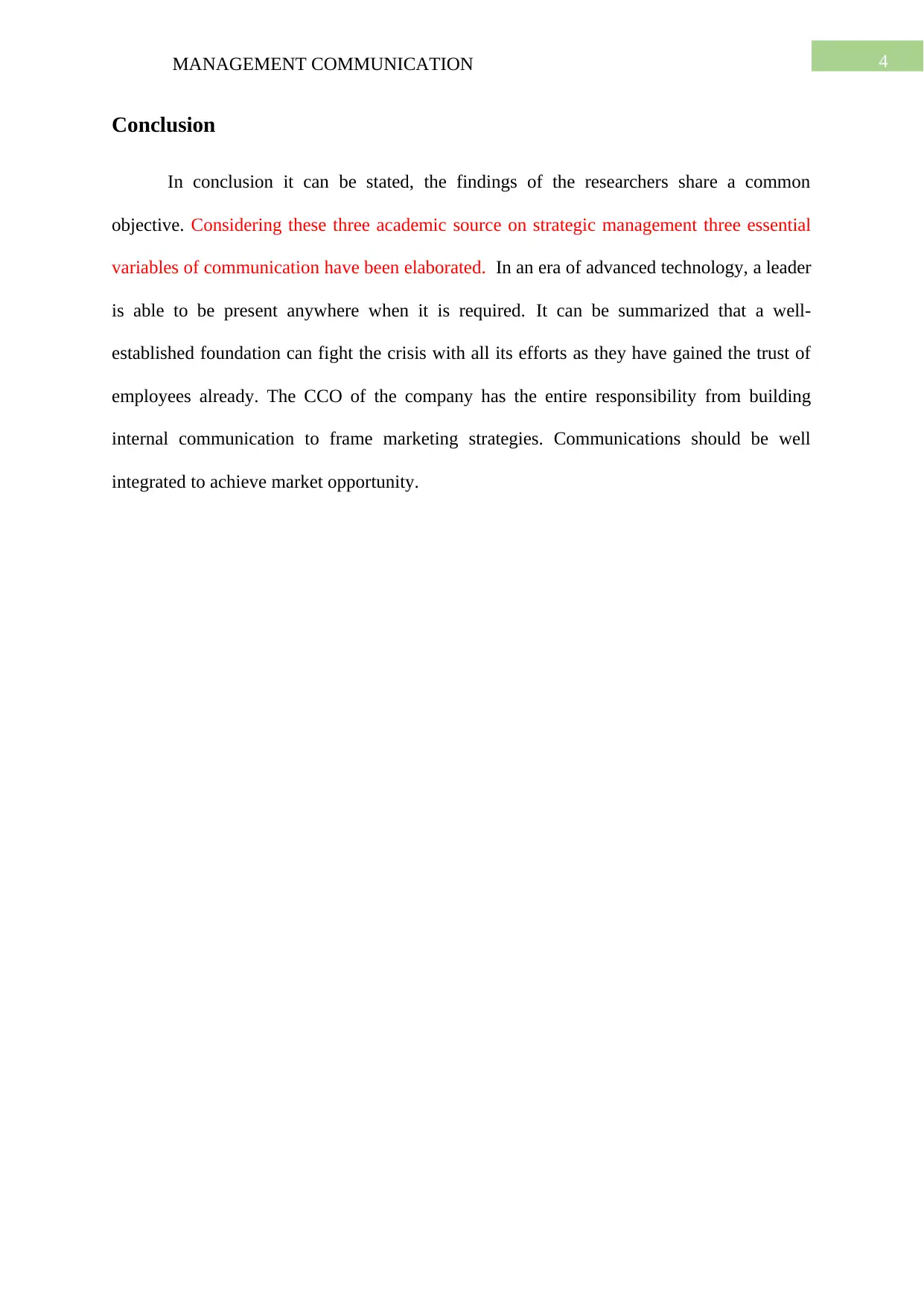
4MANAGEMENT COMMUNICATION
Conclusion
In conclusion it can be stated, the findings of the researchers share a common
objective. Considering these three academic source on strategic management three essential
variables of communication have been elaborated. In an era of advanced technology, a leader
is able to be present anywhere when it is required. It can be summarized that a well-
established foundation can fight the crisis with all its efforts as they have gained the trust of
employees already. The CCO of the company has the entire responsibility from building
internal communication to frame marketing strategies. Communications should be well
integrated to achieve market opportunity.
Conclusion
In conclusion it can be stated, the findings of the researchers share a common
objective. Considering these three academic source on strategic management three essential
variables of communication have been elaborated. In an era of advanced technology, a leader
is able to be present anywhere when it is required. It can be summarized that a well-
established foundation can fight the crisis with all its efforts as they have gained the trust of
employees already. The CCO of the company has the entire responsibility from building
internal communication to frame marketing strategies. Communications should be well
integrated to achieve market opportunity.
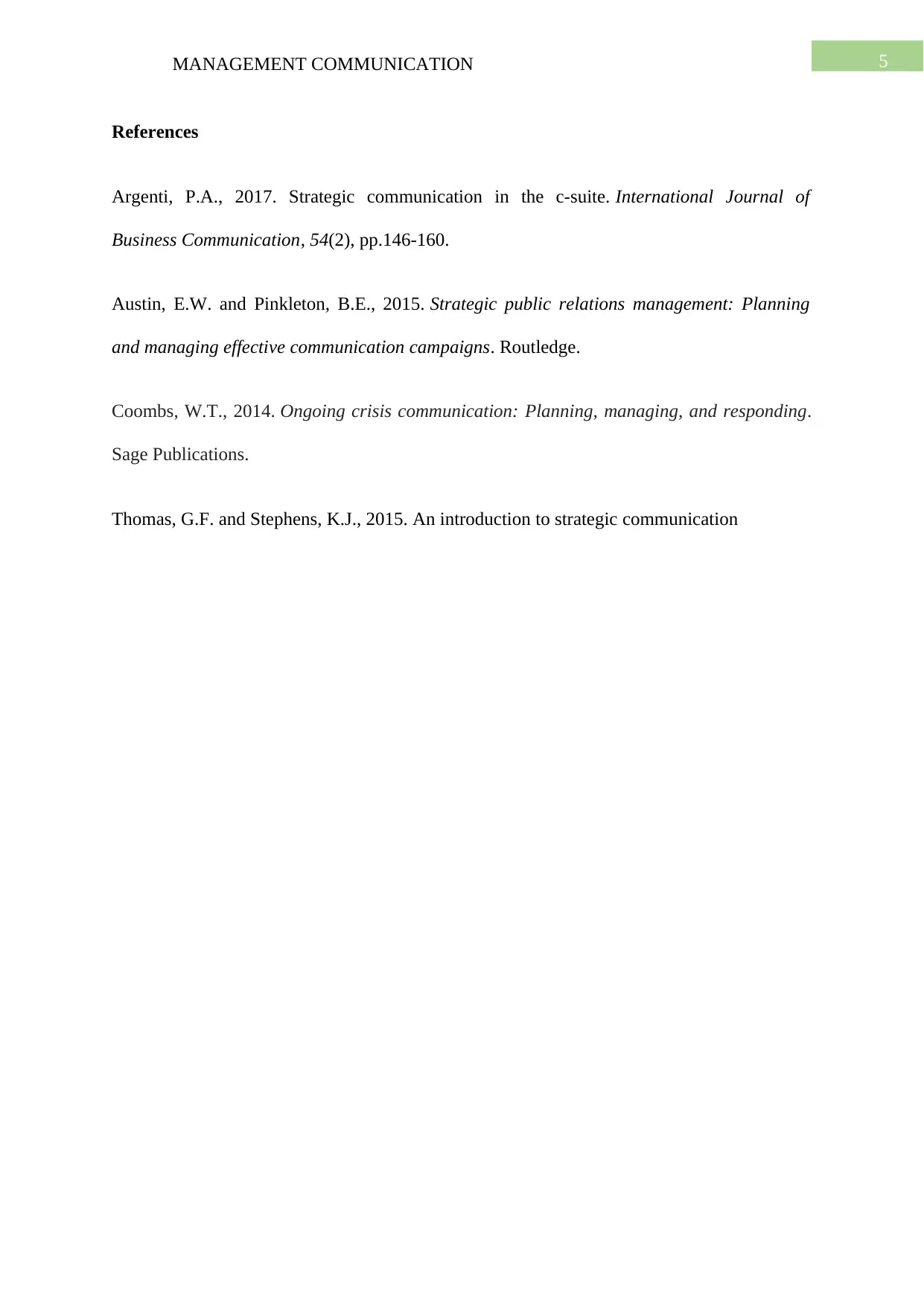
5MANAGEMENT COMMUNICATION
References
Argenti, P.A., 2017. Strategic communication in the c-suite. International Journal of
Business Communication, 54(2), pp.146-160.
Austin, E.W. and Pinkleton, B.E., 2015. Strategic public relations management: Planning
and managing effective communication campaigns. Routledge.
Coombs, W.T., 2014. Ongoing crisis communication: Planning, managing, and responding.
Sage Publications.
Thomas, G.F. and Stephens, K.J., 2015. An introduction to strategic communication
References
Argenti, P.A., 2017. Strategic communication in the c-suite. International Journal of
Business Communication, 54(2), pp.146-160.
Austin, E.W. and Pinkleton, B.E., 2015. Strategic public relations management: Planning
and managing effective communication campaigns. Routledge.
Coombs, W.T., 2014. Ongoing crisis communication: Planning, managing, and responding.
Sage Publications.
Thomas, G.F. and Stephens, K.J., 2015. An introduction to strategic communication
⊘ This is a preview!⊘
Do you want full access?
Subscribe today to unlock all pages.

Trusted by 1+ million students worldwide

6MANAGEMENT COMMUNICATION
1 out of 7
Related Documents
Your All-in-One AI-Powered Toolkit for Academic Success.
+13062052269
info@desklib.com
Available 24*7 on WhatsApp / Email
![[object Object]](/_next/static/media/star-bottom.7253800d.svg)
Unlock your academic potential
Copyright © 2020–2025 A2Z Services. All Rights Reserved. Developed and managed by ZUCOL.




